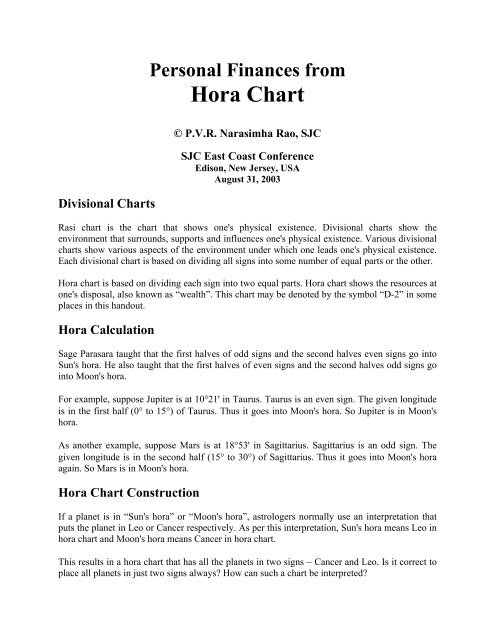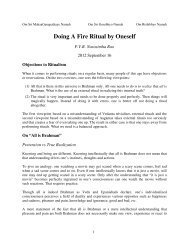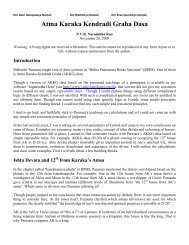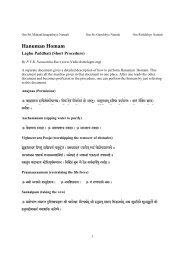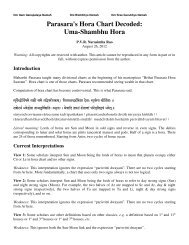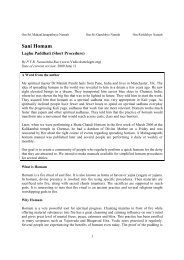Parivritti Dwaya (Bicyclical) Hora - Narasimha P.V.R. Rao
Parivritti Dwaya (Bicyclical) Hora - Narasimha P.V.R. Rao
Parivritti Dwaya (Bicyclical) Hora - Narasimha P.V.R. Rao
Create successful ePaper yourself
Turn your PDF publications into a flip-book with our unique Google optimized e-Paper software.
Divisional Charts<br />
Personal Finances from<br />
<strong>Hora</strong> Chart<br />
© P.V.R. <strong>Narasimha</strong> <strong>Rao</strong>, SJC<br />
SJC East Coast Conference<br />
Edison, New Jersey, USA<br />
August 31, 2003<br />
Rasi chart is the chart that shows one's physical existence. Divisional charts show the<br />
environment that surrounds, supports and influences one's physical existence. Various divisional<br />
charts show various aspects of the environment under which one leads one's physical existence.<br />
Each divisional chart is based on dividing all signs into some number of equal parts or the other.<br />
<strong>Hora</strong> chart is based on dividing each sign into two equal parts. <strong>Hora</strong> chart shows the resources at<br />
one's disposal, also known as “wealth”. This chart may be denoted by the symbol “D-2” in some<br />
places in this handout.<br />
<strong>Hora</strong> Calculation<br />
Sage Parasara taught that the first halves of odd signs and the second halves even signs go into<br />
Sun's hora. He also taught that the first halves of even signs and the second halves odd signs go<br />
into Moon's hora.<br />
For example, suppose Jupiter is at 10°21' in Taurus. Taurus is an even sign. The given longitude<br />
is in the first half (0° to 15°) of Taurus. Thus it goes into Moon's hora. So Jupiter is in Moon's<br />
hora.<br />
As another example, suppose Mars is at 18°53' in Sagittarius. Sagittarius is an odd sign. The<br />
given longitude is in the second half (15° to 30°) of Sagittarius. Thus it goes into Moon's hora<br />
again. So Mars is in Moon's hora.<br />
<strong>Hora</strong> Chart Construction<br />
If a planet is in “Sun's hora” or “Moon's hora”, astrologers normally use an interpretation that<br />
puts the planet in Leo or Cancer respectively. As per this interpretation, Sun's hora means Leo in<br />
hora chart and Moon's hora means Cancer in hora chart.<br />
This results in a hora chart that has all the planets in two signs − Cancer and Leo. Is it correct to<br />
place all planets in just two signs always? How can such a chart be interpreted?
Some astrologers disagree with this interpretation and use alternatives that utilize all the twelve<br />
signs.<br />
<strong>Parivritti</strong> <strong>Dwaya</strong> (<strong>Bicyclical</strong>) <strong>Hora</strong><br />
A hora chart variation known as “<strong>Parivritti</strong> <strong>Dwaya</strong> <strong>Hora</strong>” (bicyclical hora) or PD-hora was<br />
speculated on the internet a few years ago to be the correct hora chart that shows wealth. This is<br />
a cyclical chart like Navamsa and Saptamsa. In other words, the two parts of Aries go into Aries<br />
and Taurus; the two parts of Taurus go into Gemini and Cancer; the two parts of Gemini go into<br />
Leo and Virgo; the two parts of Cancer go into Libra and Scorpio; and so on. As we go through<br />
the 24 horas arrived from the 12 signs, we cyclically go around the zodiac twice.<br />
However, this chart does not satisfy the basic criterion of Parasara. If one were to use this chart,<br />
what is the meaning of Sun's hora and Moon's hora? Why are Aries, Cancer, Leo, Scorpio,<br />
Sagittarius and Pisces called “Sun's hora” and other signs called “Moon's hora”? There is no link<br />
between the signs found using this interpretation and the luminaries.<br />
This chart may be a valid chart, just like other non-Parasari variations of drekkana and<br />
chaturthamsa charts. However, this cannot be the chart Parasara referred to for examining<br />
wealth.<br />
<strong>Parivritti</strong> (Cyclical) Charts<br />
In general, parivritti-based (cyclical) charts show various factors that influence one's activities<br />
(karma). These charts throw light on various factors like the abilities, initiative, direction and<br />
judgment that go into one's activities.<br />
Table 1: Some <strong>Parivritti</strong>-based Charts<br />
Chart Symbol Matters to be seen in it<br />
<strong>Hora</strong> D-2 Family support to karma<br />
Navamsa D-9<br />
Dharma/duty (defined by ‘abilities’), the pillar<br />
supporting one's karma<br />
Drekkana D-3 The initiative behind karma<br />
Chaturthamsa D-4 The direction (gati) behind karma<br />
Panchamsa D-5 Judgment, wisdom and discretion behind karma<br />
As seen in the table above, parivritti-based hora chart shows family support to one's activities. It<br />
does not show wealth as speculated by some astrologers.
Kashinatha <strong>Hora</strong> Chart<br />
The real hora chart variation that shows wealth is known as “Kashinatha <strong>Hora</strong>” chart, named<br />
after Pt. Kashinath Rath. This chart is based on the classicfication of signs into signs that are<br />
strong during the day and signs that are strong during the night.<br />
Figure 1: Day and Night Strong Signs<br />
Sun represents day-strong signs, i.e. Leo, Virgo, Libra, Scorpio, Aquarius and Pisces. Moon<br />
represents night-strong signs, i.e. Aries, Taurus, Gemini, Cancer, Sagittarius and Capricorn.<br />
Figure 1 shows which signs are strong in day and which are strong at night.<br />
It may be noted that each planet owning exactly two signs owns one day-strong sign and one<br />
night-strong signs. There is a fable that says that Sun and Moon originally owned six signs each<br />
and gave away one sign each from their six signs to Mercury, Venus, Mars, Jupiter and Saturn.<br />
Thus, Sun's hora and Moon's hora refer to the day-strong and night-strong signs among the two<br />
signs owned by a planet. For this purpose, Leo and Cancer form a pair, even though they are not<br />
owned by the same planet.<br />
As an example, suppose Jupiter is at 25°16' in Taurus. Taurus is an even sign. The given<br />
longitude is in the second half (15° to 30°) of Taurus. Thus it goes into Sun's hora. Thus it should<br />
go into the day-strong sign owned by Venus (lord of Taurus). Thus, Jupiter is placed in Libra in<br />
Kashinatha hora chart.<br />
As another example, suppose Mars is at 18°53' in Sagittarius. Sagittarius is an odd sign. The<br />
given longitude is in the second half (15° to 30°) of Sagittarius. Thus it goes into Moon's hora.<br />
Thus it should go into the night-strong sign owned by Jupiter (lord of Sagittarius). Thus, Mars is<br />
placed in Sagittarius in Kashinatha hora chart.<br />
Exercise 1: As an exercise, look at the rasi chart and D-2 shown in Chart 1 and verify that the<br />
calculations are correct.
Chart 1
Interpretation Guidelines<br />
This hora chart shows financial gains and losses. It shows wealth, which is nothing but all the<br />
resources at one's disposal for one's activities. The financial situation at a given point of time and<br />
various financial transactions can be seen in this chart.<br />
The second lord of rasi chart is the karyesha for hora chart. This placement and strength in hora<br />
chart is a key factor, even though not the sole factor, in determining one's wealth.<br />
Sun, Mars and Jupiter are strong in day-strong signs. Moon, Mercury, Venus and Saturn are<br />
strong in night-strong signs.<br />
Houses from Lagna<br />
The following are the basic meanings of houses from lagna:<br />
1 st : Self from the viewpoint of finances<br />
2 nd : Resources at command (wealth)<br />
3 rd : Initiative, enterprise and boldness<br />
4 th : Direction in financial activities, happiness and comfort<br />
5 th : Earning ability<br />
6 th : Wealth from service, obstacles in finances<br />
7 th : Desires, interaction with others<br />
8 th : Changes, ups and downs, risks, investments, unexpected wealth<br />
9 th : Fortune and protection<br />
10 th : Money related activities in society<br />
11 th : Gains<br />
12 th : Losses<br />
Houses from Arudha Lagna (AL)<br />
The following are the basic meanings of houses from arudha lagna (AL):<br />
1 st : Image/status (in money matters)<br />
2 nd : How resourceful the native seems<br />
3 rd : Apparent initiative and enterprise<br />
4 th : Apparent activities (10 th ) of others (7 th ) and their impact on one’s finances<br />
5 th : Apparent earning abilities<br />
6 th : Apparent resistance to obstacles<br />
7 th : Others (impacting one’s finances)<br />
8 th : Resources of others and their impact on one’s finances<br />
9 th : Protection to one’s financial status<br />
10 th : Financial activities<br />
11 th : Apparent financial gains<br />
12 th : Apparent financial losses
Arudha Padas of Houses<br />
The following are the basic meanings of arudha padas of houses:<br />
AL: Overall image and status<br />
A2: The wealth and possessions<br />
A3: Enterprises and business ventures<br />
A4: Indicators of comfort and happiness in financial matters (think of examples!)<br />
A5: Events establishing earning abilities<br />
A6: Service that generates money<br />
A7: Partnerships and partners<br />
A8: Financial risks, unexpected turns/swings<br />
A9: Events making one look fortunate<br />
A10: Activities related to money, career<br />
A11: Profits, income, gains<br />
UL: Losses, expenditure<br />
In all the cases, it may be noted that the houses from arudha lagna deal with people's perceptions<br />
about various aspects of a native's finances, whereas arudha padas of houses directly show real<br />
things or events related to a native's finances.<br />
For example, UL (upapada or the arudha pada of the 12 th house) shows an amount that was lost<br />
or spent or given away. It shows a real expenditure. On the other hand, the 12 th house from AL<br />
shows a perceived loss.<br />
If a planet is in the 12 th house from AL, it may give events that make people think that the native<br />
lost money. Of course, if people think that the native lost money, he probably did lose some<br />
money.<br />
On the other hand, if a planet is in UL, it may simply give a specific loss or expense. If the same<br />
planet is in the 5 th house from AL, the specific and real loss/expense may make the native seem<br />
very capable financially. In such a case, the expense shown by the planet in UL may be wise<br />
investment that makes the native look smart and capable.<br />
By examining the houses from lagna and arudha lagna, by examining the arudha padas of various<br />
houses and by finding links between all these factors, one can make good predictions on the<br />
finances of a native.<br />
<strong>Hora</strong> Narayana Dasa<br />
Narayana dasa of the hora chart is the best tool for timing events related to a native's finances.<br />
This shows where Narayana (effort) is at a given time, in the financial environment in which<br />
one's physical existence takes place.
Calculation of <strong>Hora</strong> Narayana dasa is simple. Mark the 2 nd house in rasi chart. Find the position<br />
of its lord in hora chart. Take that sign as lagna and find Narayana dasa just like that of the rasi<br />
chart. 1<br />
For example, suppose Leo rises in rasi chart and Scorpio rises in hora chart. The 2 nd house of rasi<br />
chart is Virgo. Its lord is Mercury. Suppose Mercury is in Cancer in hora chart. Take Cancer as<br />
lagna. Start <strong>Hora</strong> Narayana dasa from the stronger of Cancer and Capricorn and find dasa<br />
sequence and dasa lengths treating hora chart as rasi chart.<br />
<strong>Hora</strong> Narayana dasa for the example of Chart 1 is given below:<br />
Narayana Dasa of D-2 chart:<br />
Maha Dasas:<br />
Sg: 1893-04-07 (9:31:00) - 1904-04-08 (5:06:22)<br />
Le: 1904-04-08 (5:06:22) - 1909-04-08 (11:54:04)<br />
Ar: 1909-04-08 (11:54:04) - 1910-04-08 (18:05:43)<br />
Pi: 1910-04-08 (18:05:43) - 1914-04-08 (18:37:10)<br />
Sc: 1914-04-08 (18:37:10) - 1920-04-08 (7:36:00)<br />
Cn: 1920-04-08 (7:36:00) - 1927-04-09 (2:35:16)<br />
Ge: 1927-04-09 (2:35:16) - 1933-04-08 (15:34:52)<br />
Aq: 1933-04-08 (15:34:52) - 1936-04-08 (9:56:52)<br />
Li: 1936-04-08 (9:56:52) - 1942-04-08 (23:05:39)<br />
Vi: 1942-04-08 (23:05:39) - 1951-04-09 (6:19:28)<br />
Ta: 1951-04-09 (6:19:28) - 1962-04-09 (1:59:26)<br />
Cp: 1962-04-09 (1:59:26) - 1966-04-09 (2:46:12)<br />
Sg: 1966-04-09 (2:46:12) - 1967-04-09 (8:52:54)<br />
Le: 1967-04-09 (8:52:54) - 1974-04-09 (3:50:44)<br />
Ar: 1974-04-09 (3:50:44) - 1985-04-08 (23:32:10)<br />
Pi: 1985-04-08 (23:32:10) - 1993-04-09 (0:51:21)<br />
Sc: 1993-04-09 (0:51:21) - 1999-04-09 (13:47:20)<br />
Cn: 1999-04-09 (13:47:20) - 2004-04-08 (20:30:10)<br />
Each dasa is judged by examining the dasa sign (or the 7 th from it, if dasas were initiated from<br />
the 7 th ). The placement of dasa sign and its paaka (sign containing dasa sign's lord) from lagna<br />
and its bhoga (arudha pada of dasa sign) from AL are examined. One can get more information<br />
from “Narayana Dasa” book authored by Pt. Sanjay Rath.<br />
One can use the principle of three parts very effectively, when timing events related to personal<br />
finances using <strong>Hora</strong> Narayana dasa.<br />
If a dasa is divided into three parts, the distribution of the results given by various factors<br />
changes based on how the sign rises. Signs that rise with their head, signs that rise with their<br />
back and sign that rise with both are marked in Figure 2.<br />
1 For commercial software that can find Narayana dasa of all divisional charts, please visit<br />
http://www.VedicAstrologer.org (this presenter's website).
Figure 2: Rising of signs<br />
The results given in the three parts are listed in Table 2.<br />
Table 2: Principle of three parts<br />
Udaya Rises with First 1/3 rd Second 1/3 rd Third 1/3 rd<br />
Seershodaya Head House Lord<br />
Prishthodaya Back<br />
Ubhayodaya Both<br />
Examples<br />
Occupants and<br />
aspectors<br />
Occupants and<br />
aspectors<br />
Lord<br />
Occupants and<br />
aspectors<br />
House<br />
House Lord<br />
Now, let us go through some examples to consolidate the knowledge. In the class, we will open<br />
the example charts in “Jagannatha <strong>Hora</strong>” software and go through the hora chart and <strong>Hora</strong><br />
Narayana dasa.<br />
Example 1: Consider the native of Chart 1. Birthdata is given in the middle of the chart.<br />
Karyesha, i.e. the 2 nd lord of rasi chart, is Mercury. He is placed in an upachaya (house of<br />
growth) from lagna and trine from AL in hora chart. More significantly, he is placed in GL (ghati<br />
lagna) in hora. Thus the native is successful, amasses wealth and attains influence and power in<br />
his financial life.<br />
Let us start analyzing his <strong>Hora</strong> Narayana dasa, starting from Cancer dasa (1920-1927). Cancer is<br />
the 12 th from AL and does not show much gains. Having A6 in it, it shows some struggle.<br />
However, its lord is debilitated in the 2 nd house and it contains HL (money available to one).<br />
Thus, the dasa has mixed influences and shows success after struggle.
Gemini dasa (1927-1933) was very crucial in the finances of this natives. Gemini is the 11 th from<br />
AL and shows financial gains. It contains A7 and shows business ventures and partnerships. Its<br />
lord Mercury is a functional benefic, as he owns the 9 th and 12 th houses. He is well-placed in the<br />
5 th house from AL and shows excellent financial capabilities. As Mercury conjoins UL, he shows<br />
expenses. However, considering his good placement, these expenses are investments that enrich<br />
the native's image. Being in the 3 rd house from lagna, he shows initiative and bold actions.<br />
Mercury is the planet of business and trading. Thus, the native takes bold actions and engages in<br />
various businesses and succeeds.<br />
One of the indications of Mercury and Gemini is sugarcane 2 . So sugar mills are a possibility.<br />
Mercury in Sagittarius can also show insurance business. The native bought a big insurance<br />
company in Gemini dasa!<br />
In Libra dasa, he founded a Cement factory, the first in India. Libra's lord is exalted. Its bhoga<br />
conjoins AL. Thus it is an important dasa. It contains Ketu in the 3 rd from AL (good placement<br />
for a malefic). Its lord Venus is exalted in the 8 th from AL (good placement for a benefic). Libra<br />
contains A3. So there was a new enterprise. Ketu shows buildings, construction materials etc and<br />
can show cement too. Thus Libra dasa gave him a cement factory.<br />
Virgo dasa was the most important in his financial life. Always, the 2 nd house from AL is very<br />
important, as it feeds the image. Saturn is a yogakaraka for Libra lagna. Placed in the 2 nd from<br />
AL, he feeds the image well. Moreover, its lord Mercury is in the 3 rd house (of enterprise) from<br />
lagna and 5 th house from AL (image of a capable person), along with UL<br />
(expenses/investments). Unlike the Gemini dasa, bhoga is also well-placed in the case of Virgo<br />
dasa. Bhoga of Virgo is in a trine from AL. Thus, Virgo dasa is the most brilliant dasa of all.<br />
Mercury gave him banking and publishing. He started “Bharat Bank” and bought “The Times of<br />
India”, one of the biggest newspapers in those times. He acquired some managing and marketing<br />
agencies too. He was also involved with some coal mines (notice Saturn!).<br />
Towards the end of Saturn dasa, the native suffered incarcetation. Notice that Taurus is the 8 th<br />
house and shows upheavals. It is the 10 th house of activities from AL. As it contains a malefic, it<br />
shows bad reputation. Mars shows litigation. Bhoga of Taurus is in a dusthana from AL. Taurus<br />
contains Mars, who is the 2 nd and 7 th lord and hence a strong maraka in the hora chart. He shows<br />
a death-like situation or a serious problem in financial life. A malefic afflicting A4 shows lack of<br />
comfort in financial matters. Moreover, Mars is the naisargika vedha (obstructor) for Saturn and<br />
Mercury, two trine lords and key planets in this chart. So he obstructs the good financial fortune.<br />
Jupiter is the 3 rd and 6 th lord and a functional malefic. Being the 6 th lord and being the planet of<br />
law, he can show problems with law. Taurus is the karaka sthana for Jupiter as per pachakadi<br />
sambandha and hence can promote Jupiter's results. For all these reasons, the native was<br />
convicted.<br />
This chart belongs to Sri Ramkrishna Dalmiya, an Indian industrialist.<br />
2<br />
That is why Mercury represents Tripurasundari among the forms of Divine Mother, who is depicted holding a<br />
sugar cane in Her hand.
Example 2: Consider the native of Chart 2. Birthdata is given in the middle of the chart.<br />
Chart 2<br />
The 2 nd house of rasi chart is Scorpio. Its lord in hora chart is Mars. So he is karyesha. He is<br />
well-placed in the the 5 th house and takes part in a raja yoga with Saturn. He is placed in a<br />
quadrant from AL too. So the hora chart is basically strong. The native is wealthy.<br />
In addition, one may notice that Moon and Jupiter conjoin in lagna in all the six divisional charts<br />
belonging to shadvarga. Thus, they give a raja yoga in addition to Gaja-Kesari yoga. It makes the<br />
native very popular. The chart belongs to Mr. N.T. Rama <strong>Rao</strong>, an immensely successful south<br />
Indian film actor who was a demigod in a south Indian state called AP for many decades. He<br />
enacted mythological characters such as Lord Rama and Lord Krishna with great flair and is<br />
remembered for those roles even now, several decades later. Later, he became a politician and<br />
become the Chief Minister of AP.<br />
Though his career as an actor had started earlier, it was during Pisces dasa (1957-1967) that he<br />
really became a big star. He was an icon in AP and started demanding big compensation. It must<br />
be noted that Pisces contains AL and shows building of an image. Its lord is well-placed in lagna.<br />
It is the 11 th house from lagna. Its bhoga is in the 5 th house from AL. All these factors suggest an<br />
excellent period financially. Moreover, it must be noted that Pisces aspects the raja yoga between<br />
7 th lord Mars and yogakaraka Saturn in Virgo.<br />
The next important dasa is Gemini (1983-1994). As soon as Gemini dasa started in May 1983, he<br />
was elected as the Chief Minister of an Indian state (head of the executive wing of state<br />
government). For most of Gemini dasa, he continued in that position.
It may be noted that Gemini contains GL and shows resources/wealth related to power and<br />
authority. It is the 2 nd house of wealth from lagna and its lord is in lagna. Its bhoga is in the 2 nd<br />
house from AL and a benefic occupied it. Thus, it is a good dasa. As it aspects the raja yoga in<br />
Virgo, as it aspects the 5 th house and as it contains GL, it gave power.<br />
One thing that may be noted in this chart is that UL is in the 12 th house from AL, whereas it is in<br />
the 5 th house from AL in Chart 1. As Gemini is a trine from UL and UL lord aspects it, the result<br />
may be given in Gemini dasa. NTR, as he was popularly known, became the Chief Minister, but<br />
refused to accept a fat salary. He instead argued he was rich and did not need more money and<br />
said the poor people of his state needed that money. He took a token salary of one rupee (about<br />
two cents). UL can show a loss or giving up something. Being in the 12 th from AL, it shows an<br />
act that makes people think that he is actually losing (or giving up) financially. However,<br />
Aquarius is the 10 th house from the AL lord of rasi chart. Hence his overall image was positively<br />
affected by this and it was seen as a good act.<br />
More Examples<br />
More detailed examples will be covered at the class. They will also be available in the MP3 CD's<br />
of the class.<br />
Conclusion<br />
Kashinatha <strong>Hora</strong> chart based on day-strong and night-strong signs is the correct hora chart<br />
variation for examining financial matters. Houses from lagna and AL, as well as arudha padas of<br />
various houses, can be examined for judging the strengths and weaknesses of a chart from the<br />
point of view of personal finances. <strong>Hora</strong> Narayana dasa can be used for fine timing of events<br />
related to finances.<br />
:: Om Tat Sat ::


